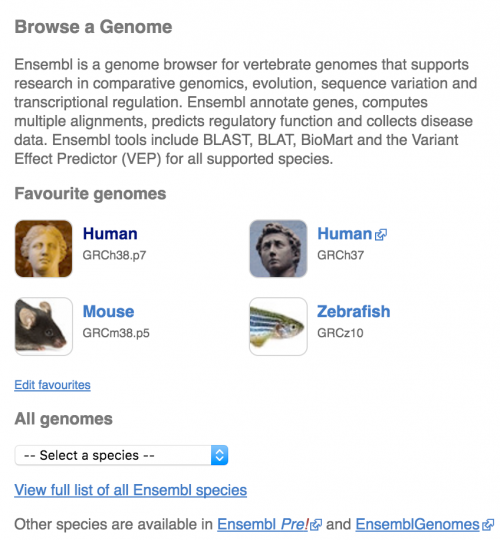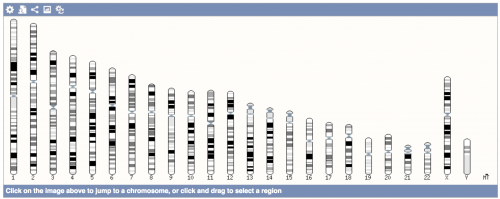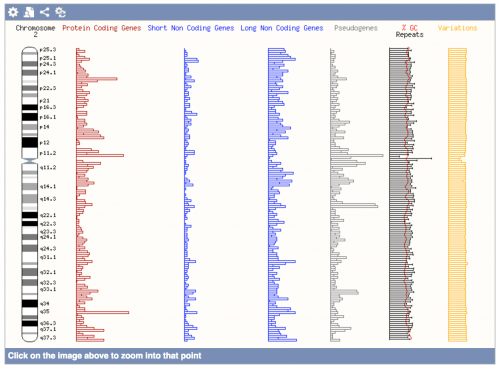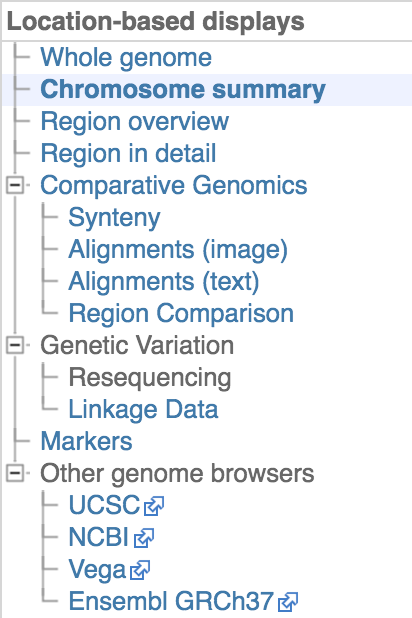Later today, I’m going to chat with some folks about the creationist claim that human chromosome 2 is not the product of a fusion of chromosomes 2A and 2B in a primate ancestor. I’ve mentioned this guy before, Jeffrey Tomkins, and I’ve criticized the silliness of his approach, which involves staring fixedly at the putative fusion site and ignoring everything else and pompously declaring that he doesn’t see what he expects to see. My response is always “LOOK AT THE SYNTENY OF THE WHOLE CHROMOSOME, YOU ADDLED DOOFUS!”
Synteny is the conservation of blocks of order within two sets of chromosomes that are being compared with each other. That is, stop looking at one tiny little spot and look at the whole chromosome, and ask if there are similar genes in a similar order between human chromosome 2 and chimpanzee chromosomes 2A and 2B. That’s the evidence.
And then I realized that most people don’t know how to look at the genomic data and do these kinds of comparisons. So in this post I’m going to tell you how to do that. It’s fun! It’s easy! It’s like a little game!
First step: go to ensembl.org. Here’s what you’ll see:
We’re going to select “human”. GRCh38.p7 is just the latest, most up-to-date, complete assembly. You can come back later if you want to play with all that data from other species.
Oh, look. You could suck in the whole human genome sequence to your computer, but then you’d be wondering how to read it and what you can do with it, and might turn into a bioinformatician. Play it safe and easy for now and click on “view karyotype”.
There you are, all 23 human chromosomes and the mitochondrial genome! For now, just click on chromosome 2. From the popup menu, choose “view summary”.
That’s a tempting summary map of what is on chromosome 2, but ignore it for now. Look at top left menu.
Select “Synteny” from the “Comparative Genomics” section.
It’s going to default to showing you how regions with similar sequences line up with human chromosome 2. That’s interesting — you can see that human chromosome 2 is made up of chunks of DNA from mouse chromosomes 12, 17, 6, 1, 19, 16, 5, 11, 2, 10, and 18, but use “Change Species” to switch to “Chimpanzee”. It’s simpler, because we are more closely related to chimps than to mice. Shocking, I know.
Are we done now?
Now if you’d like, you can play with looking at other chromosomes. Or if you’re really clever, you’ll just browse the zebrafish genome.








Ha! I did it different, ’cause I’ve got initiative and stuff!
1) I started with Chimpanzee 2A/2B, and compared them to Human
2) I (re)started with Human 2, but chose Orangutan instead of Chimpanzee to compare. Oook!
More seriously: Does Tomkins accept that it’s reasonable to compare chromosomes between related species at all? Like mice and rats? Cows and sheep? Dogs and pandas?
Does he even agree that the above pairs are more closely related to each other than to other animals at all?
I hope the poor chap doesn’t notice chromosome 3 – he’d have a breakdown!
They’re strangely lacking in data for cephlapods – how would that compare, or would it be too heartbreaking to see such obviously superior DNA?
Or, to add on to my question @#1: According to secular biology, organisms are all related in one huge sprawling billions-of-years-old tree of life. According to YEC, organisms are from a forest of trees created a few thousand years ago. So, secularly, rats and mice are murines; cows and sheep are bovids; dogs and bears are caniformes. At what point does YEC consider the “kinds” to have been created differently?
Does YEC assert that all of the above are different “created kinds”? If yes, is it completely wrong to compare their different YEC trees-of-life? If no, how is comparing two branches from one YEC tree different from comparing organisms from two YEC trees that are considered related by secular biology? And at what point do YECs insist that the kinds are actually different? Are murines from one YEC tree or two separate ones? How about bovids? And caniformes?
(Sorry if #3 is a bit repetitive or confused)
“Ensembl is a genome browser for vertebrate genomes”. That’s why no cephalopods.
This, seriously, is what makes me love Pharyngula.
Learning stuff, snark, the naked implication that bioinformatics is a truly dangerous occupation – that’s what prompted me to fall in love with Pharyngula.
The social justice stuff? That just establishes a baseline of decency. Without learning where to view a karyotype and how to understand the information presented, I don’t know that I would have kept up my interest here.
Now I just need to get my 8 year old to read this post without her eyes glazing over. She’ll share my delight at this post, right? Right?
@Owlmirror #1 – Creationists don’t usually have a problem with the fact that human and chimp chromosomes are more similar than human and mice chromosomes, they just explain it as a result of the functional similarities: since God decided to make chimps look more like humans than mice, naturally their DNA would also look more similar. A favorite example back when I was still in the church was “fish and submarines look similar, but one didn’t evolve from the other.” Naturally, the fact that you can trace the same evolutionary relationships based on sequence similarities in non-coding DNA is a major problem for this argument, which is why creationists get so excited whenever a new function is discovered for “junk DNA.”
@Sarah A:
Maybe some creationists are like that, sometimes, but I seem to recall inconsistent and confused positions on the matter. And the case in point is Jeffrey Tomkins, that PZ is writing about — Tomkins does not argue that God made the chimpanzee chromosome 2A and 2B similar to human chromosome 2 so that chimpanzees would be similar to humans; he’s arguing that the similarity does not exist.
Sarah A – That implies that fish and whale DNA should be more similar too. Oh no, another favorite creationist argument down the drain!
I thought of more questions about Tomkins’ position.
Are all the non-human great apes one created kind; one isolated YEC tree-of-life? If not, presumably they are part of the monkey YEC tree-of-life. Is that joined with the lemur YEC tree-of-life?
And so on. Do YECs even have a consistent position on the number and relationships of the primate tree(s)-of-life/baraminim?
Incidentally, I see that ensembl has a full species tree which does include a few non-vertebrates, presumably for outgroup comparisons. No cephalopods, though — sea squirts and yeast are all they’ve got.
Me @#10:
And a slight correction: Also C. elegans and mosquitoes.
@PZ, minor fix to your instructions:
On my browser (Safari/OSX), the popup showed not “view summary” but “Jump to region view” and “Chromosome summary”. The summary was the right one.
Very cool browser thing.
I’d never seen that. It seems much more user-friendly than the UCSC genome browser that I’ve always used.
And what pray tell is wrong with being a bioinformatician?
Well, no, they don’t look similar. At all.
Can somewhat describe in a bit more detail what’s going on in the comparison chart? What do the colors refer to? Why are 3 chimp chromosomes (are 2A and 2B different?) listed on the left, but only 2 (X, 9) are on the right? What do black lines mean, and what to dark red lines mean? What do green and pink lines signify?